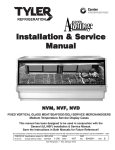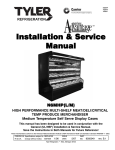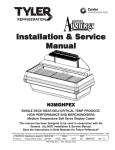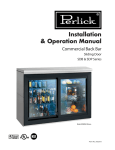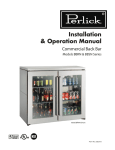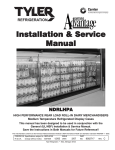Download Installation & Service Manual
Transcript
Installation & Service Manual LVM, LVF, LVD VERTICAL GLASS MEAT/SEAFOOD/DELI MERCHANDISERS Medium Temperature Service Display Cases This manual has been designed to be used in conjunction with the General Installation & Service Manual. Save the Instructions in Both Manuals for Future Reference!! This merchandiser conforms to the Commercial Refrigeration Manufacturers Association Health and Sanitation standard CRS-S1-96. PRINTED IN Specifications subject to REPLACES IN U.S.A. change without notice. EDITION 1/97 ISSUE DATE 7/99 Tyler Refrigeration Corporation * Niles, Michigan 49120 PART NO. 9027529 REV. B LVM, LVF, LVD Tyler Refrigeration CONTENTS Page Specifications LVM/LVF/LVD Specification Sheets . . . . . . . . . . . . . . . . . . . . . . . . . 4 Line Sizing Requirements . . . . . . . . . . . . (See General I&S Manual) Pre-Installation Responsibilities . . . . . . . . . . . (See General I&S Manual) Installation Procedures Carpentry Procedures . . . . . . . . . . . . . . . . . . . . . . . . . . . . . . . . . 6 Case Line-Up . . . . . . . . . . . . . . . . . . . . . . . . . . . . . . . . . . . . . . . . 6 Trim Installation . . . . . . . . . . . . . . . . . . . . . . . . . . . . . . . . . . . . . . . 7 Plumbing Procedures . . . . . . . . . . . . . . (See General I&S Manual) Refrigeration Procedures . . . . . . . . . . . . . . . . . . . . . . . . . . . . . . . 8 Temperature Control . . . . . . . . . . . . . . . . . . . . . . . . . . . . . . . . . . . . 8 Setting Electronic Thermostat (LVM/LVF) . . . . . . . . . . . . . . . . . . . . 9 Electrical Procedures . . . . . . . . . . . . . . . . . . . . . . . . . . . . . . . . . . 9 Electrical Considerations . . . . . . . . . . . . . . . . . . . . . . . . . . . . . . . . 9 Defrost Information . . . . . . . . . . . . . . . . . . . . . . . . . . . . . . . . . . . . 9 Defrost Control Chart . . . . . . . . . . . . . . . . . . . . . . . . . . . . . . . . . . . 9 Installation Procedure Check Lists . . . . (See General I&S Manual) Wiring Diagrams . . . . . . . . . . . . . . . . . . . . . . . . . . . . . . . . . . . . . . . . . . 9 LV(M/F/D) Domestic & Export (50Hz) Case Circuits (6’ Cases) . . . 10 LV(M/F/D) Domestic & Export (50Hz) Case Circuits (8’ Cases) . . . 11 LV(M/F/D) Domestic & Export (50Hz) Case Circuits (12’ Cases) . . 12 Cleaning and Sanitation Stainless Steel Cleaning Methods . . . . . . . . . . . . . . . . . . . . . . . . 13 General Information Rear Sliding Door Removal and Installation . . . . . . . . . . . . . . . . . 15 Mezzanine Shelving . . . . . . . . . . . . . . . . . . . . . . . . . . . . . . . . . . . 15 Service Case Flush System . . . . . . . . . . . . . . . . . . . . . . . . . . . . . 16 Top Mounted Scale Shelf Installation . . . . . . . . . . . . . . . . . . . . . . 17 Page 2 October, 1996 Installation & Service Manual LVM, LVF, LVD Page Service Instructions Preventive Maintenance . . . . . . . . . . . . (See General I&S Manual) Light Servicing . . . . . . . . . . . . . . . . . . . . . . . . . . . . . . . . . . . . . . 18 Ballast and Lighting Locations . . . . . . . . . . . . . . . . . . . . . . . . . . . 18 Fan Blade and Motor Replacement . . . . (See General I&S Manual) Color Band and Bumper Replacement . (See General I&S Manual) Parts Information Operational Parts List . . . . . . . . . . . . . . . . . . . . . . . . . . . . . . . . . 19 Cladding and Trim Parts List . . . . . . . . . . . . . . . . . . . . . . . . . . . 20 TYLER Warranty . . . . . . . . . . . . . . . . . . . . . . . (See General I&S Manual) The following Medium Temperature Vertical Glass Meat, Seafood and Deli Service Merchandiser models are covered in this manual: MODEL DESCRIPTION LVM 6’, 8’ & 12’ VERTICAL GLASS GRAVITY COIL MEAT SERVICE MERCHANDISER LVF 6’, 8’ & 12’ VERTICAL GLASS GRAVITY COIL SEAFOOD SERVICE MERCHANDISER LVD 6’, 8’ & 12’ VERTICAL GLASS FORCED AIR DELI SERVICE MERCHANDISER January, 1997 Page 3 LVM, LVF, LVD Tyler Refrigeration LVM/LVF/LVD Vertical Glass Service Merchandiser Specification Sheets Page 4 October, 1996 Installation & Service Manual LVM, LVF, LVD LVM/LVF/LVD Vertical Glass Service Merchandiser January, 1998 Page 5 LVM, LVF, LVD INSTALLATION PROCEDURES Carpentry Procedures Case Line-Up Before starting the case line-up, review the store layout floor plans and survey the areas where case line-ups are going to be installed. Tyler Refrigeration NOTE A foam gasket is factory installed on one end of the case. This gasket fits into a groove on the adjoining case when cases are pulled together. Do not depend on the foam gasket alone to make a good seal! WARNING These cases are very heavy and require two or more people to move and/or position them. Improper handling of these cases could result in personal injury. 3. Apply two heavy beads of caulking compound from the Filler Kit to the end of case at dotted (. . .) and dashed (- - -) lines. Proper caulking provides good case refrigeration and sanitation. 1. Snap chalk lines where the front and rear base rails of the case are to be located for the entire line-up. 4. Remove shipping tape from color band backer and bumper backer. NOTE Front and rear edges of base rails should always be used to line-up cases. 6” shims allow adjoining ends of cases to be shimmed together. 2. Locate highest point on chalk lines as a reference for determining the number of shims to be placed under the case base rails. Position first case at highest point on the chalk lines and shim case supports as required. Check leveling across the top of the case . CAUTION 5. Push cases tightly together making sure the pull-ups are aligned. 6. Add shims (1), as required, under the adjoining case base rails (2). Check leveling at top of the case (3). If the base of this case is not sitting evenly on the floor, the case could warp when loaded and possibly break the glass. Page 6 October, 1996 Installation & Service Manual CAUTION LVM, LVF, LVD Trim Installation Do not drill or use other holes through the case end for pull-ups. This may deform the case end and could cause joint leaks and/or poor refrigeration. 7. Position pull-up bolts and mounting hardware at pull-up locations (A, B, C and D). Do not tighten any pull-up hardware until all of it has been installed. Tighten all pull-up hardware equally starting at point A and finishing at point D. Do not overtighten. All joint trim and mounting hardware is shipped loose. Joint trim includes rear base joint trim (1), rear lower joint trim (2), rear upper joint trim (3), top joint trim (4), outer and inner glass joint trim (5), compound tape (6) and horizontal joint trim (7). Horizontal joint trim covers gaps between the cases. The trim is glued onto the shipping cardboard. It is applied after running beads of caulking on the edges of the cases. Sheet metal screws or pop-rivets can be used for additional securing. NOTE Compound sealing tape can be added to inside surfaces of inner and outer glass joint trim to make the trim level and even. Glass joint trim pieces are secured to inside and outside of the glass joint with compound tape. Patch end trim is shipped factory installed. The compound tape has already been installed under the trim. Check and/or trim any exposed compound tape. See “General I&S Manual” for bumper and color band installation and alignment. October, 1996 Page 7 LVM, LVF, LVD Refrigeration Procedures Tyler Refrigeration THERMOSTAT BULB PLACEMENT Refrigeration system and superheat instructions can be found in the “General I&S Manual”. Service case temperature control information is listed below. Temperature Control The temperature of each case is controlled with a thermostat and suction line solenoid. One thermostat and one solenoid are required for up to three cases. The LVM and LVF cases use a gravity coil with an electronic thermostat for improved temperature control. LVD cases use a conventional mechanical thermostat. Typical Service Case with Gravity Coil Typical Service Case with Blower Coil THERMOSTAT BULB MOUNTED UNDERNEATH COIL Page 8 In addition to the thermostat and suction solenoid, a suction stop EPR valve is required in the suction line. The EPR valve acts as a low pressure limit to aid in the overall temperature control. October, 1996 Installation & Service Manual LVM, LVF, LVD Setting Electronic Thermostat (LVM/LVF) NOTE 1. Remove the four screws and cover from the electronic thermostat. The ballast box is located at the lower left rear corner of the case. It houses ballasts and terminal blocks. 2. Set the heating/cooling jumper blocks to the “COOL” position. 3. Adjust the differential potentiometer marked “DIFF” to 10°F (LVM) or 1°F (LVF). 4. Position the setpoint dial, on the front cover, to 29°F (LVM) or 34°F (LVF). 5. Check the temperature cycles by suspending a thermometer in the same general area as the thermostat probe. The temperature should cycle between 19°F and 29°F (LVM) or 33°F and 34°F (LVF). 6. Replace the cover and secure with four screws. With the cooling mode selected, the differential is below the setpoint. The relay will energize and the LED indicator will illuminate when the temperature reaches the setpoint (29°F or 34°F). When the temperature drops to the setpoint (29°F or 34°F) minus the differential setting (10°F or 1°F), the relay and LED indicator will de-energize and refrigeration will stop. Start the refrigeration system (note that the LED indicator is illuminated) and allow the case to cool. This allows the thermostat to cycle the suction solenoid valve from open to close. The settings above are specific to TYLER service cases with gravity coils only. Other applications will require different setpoints Electrical Procedures Electrical Considerations CAUTION Make sure all electrical connections at components and terminal blocks are tight. This prevents burning of electrical terminals and/or premature component failure. October, 1996 Case Fan Circuit (LVD Only) This circuit is to be supplied by an uninterrupted, protected 120V circuit. The case fan circuit is not cycled on this case. Fluorescent Lamp Circuit LV(M/F/D) case lighting is supplied by T-8 electronic ballast lights. It is controlled by a light switch in each case. The standard lighting is 1-row of T-8 canopy lights. Defrost Information See “General I&S Manual” for operational descriptions for each type of defrost control. Defrost Control Chart LVM/LVF Defrost Option Settings Defrost Defrost Defrosts Duration Type Per Day (Min) Off Time 1 110 Term. Temp. ----- LVD Defrost Option Settings Defrost Defrost Defrosts Duration Per Day (Min) Type Off Time 1 60 Term. Temp. ----- Thermostats and sensors are shown on page 8 of this manual. WIRING DIAGRAMS ELECTRICIAN NOTE - OVERCURRENT PROTECTION 120V circuits should be protected by 15 or 20 Amp devices per the requirements noted on the cabinet nameplate or the National Electrical Code, Canadian Electrical Code - Part 1, Section 28. 208V defrost circuits employ No. 12 AWG field wire leads for field connections. On remote cases intended for end to end line-ups, bonding for ground may rely upon the pull-up bolts. Page 9 LVM/LVF/LVD Domestic & Export (50Hz) Case Circuits (6’ Cases) Page 10 January, 1997 LVM/LVF/LVD Domestic & Export (50Hz) Case Circuits (8’ Cases) January, 1997 Page 11 LVM/LVF/LVD Domestic & Export (50Hz) Case Circuits (12’ Cases) Page 12 January, 1997 Installation & Service Manual LVM, LVF, LVD CLEANING INSTRUCTIONS WARNING TYLER Refrigeration does not recommend the use of high pressure cleaning equipment on service style cases!! The sealing of front glass and end joints is critical in these cases and high pressure cleaners can penetrate and/or damage these seals. Damaged seals allow water leaks and/or air leaks that can cause poor case refrigeration. CAUTION • When cleaning this case, try not to introduce water into the case faster than it can be carried away by the waste outlet. • Always use a soft cloth or sponge with mild detergent and water to clean the front glass. Never use abrasives or scouring pads to clean glass. They can scratch and/or damage the glass. See “General I&S Manual” for case cleaning instructions. Stainless steel cleaning is covered in the following chart. Stainless Steel Cleaning Methods The cleaning data in the following stainless steel cleaning chart was supplied by AISI. The information was supplied by Prime Metals Division, Alumax Aluminum Corporation. TYPE OF CLEANING CLEANING AGENT* APPLICATION METHOD** EFFECT ON FINISH Routine cleaning Soap, ammonia or detergent and water. Sponge with cloth, then rinse with clear water and wipe dry. Satisfactory for use on all finishes. Smears and fingerprints Arcal 20, Lac-O-Nu, Lumin Wash O’Cedar Cream Polish, Stainless Shine Rub with cloth as directed on the package. Satisfactory for use on all finishes. Provides barrier film Apply with damp sponge or cloth. Satisfactory for use on all finishes. Rub with damp cloth. Satisfactory for use on all finishes if rubbing is light. Grade FFF Italian pumice, whiting or talc Rub with damp cloth. Use in direction of polish lines on No. 4 (polished) finish. May scratch No. 2 (mill) and No. 7 and 8 (polished) finishes. Liquid NuSteel Rub with dry cloth. Use a small amount of cleaner. Use in direction of polish lines on No. 4 (polished) finish. May scratch No. 2 (mill) and No. 7 and 8 (polished) finishes. Paste NuSteel or DuBois Temp Rub with dry cloth. Use a small amount of cleaner. Use in direction of polish lines on No. 4 (polished) finish. May scratch No. 2 (mill) and No. 7 and 8 (polished) finishes. Cooper’s Stainless Steel Cleaner, Revere Stainless Steel Cleaner Apply with damp sponge or. cloth. Use in direction of polish lines on No. 4 (polished) finish. May scratch No. 2 (mill) and No. 7 and 8 (polished) finishes. Household cleaners (Old Dutch, Lighthouse, Sunbrite, Wyandotte, Bab-O, Gold Dust, Sapolio, Bon Ami, Ajax or Comet) Rub with a damp cloth. May contain chlorine bleaches. Rinse thoroughly after use, if left on surface, may lead to corrosion. Use in direction of polish lines on No. 4 (polished) finish. May scratch No. 2 (mill) and No. 7 and 8 (polished) finishes. Stubborn spots and Allchem Concentrated stains, baked-on Cleaner splatter, and other light discolorations Samae, Twinkle, or Cameo Copper Cleaner July, 1999 Page 13 LVM, LVF, LVD TYPE OF CLEANING CLEANING AGENT* Tyler Refrigeration APPLICATION METHOD** EFFECT ON FINISH Grade F Italian pumice, Steel Rub with a damp cloth. Bright, Lumin Cleaner, Zud, Restoro, Bon Ami, Ajax or Comet Use in direction of polish lines on No. 4 (polished) finish. May scratch No. 2 (mill) and No. 7 and 8 (polished) finishes. Penny-Brite or Copper-Brite Rub with a dry cloth. Use a small amount of cleaner. Use in direction of polish lines on No. 4 (polished) finish. May scratch No. 2 (mill) and No. 7 and 8 (polished) finishes. Penny-Brite or Copper-Brite Rub with a dry cloth. Use in direction of polish lines on No. 4 (polished) finish. May scratch No. 2 (mill) and No. 7 and 8 (polished) finishes. Paste NuSteel or DuBois Temp Rub with dry cloth. Use a small amount of cleaner. Use in direction of polish lines on No. 4 (polished) finish. May scratch No. 2 (mill) and No. 7 and 8 (polished) finishes. Revere Stainless Steel Cleaner Apply with a damp sponge or cloth. Use in direction of polish lines on No. 4 (polished) finish. May scratch No. 2 (mill) and No. 7 and 8 (polished) finishes. Allen Polish, Steel Bright, Wyandotte, Bab-O or Zud Rub with a damp cloth. Use in direction of polish lines on No. 4 (polished) finish. May scratch No. 2 (mill) and No. 7 and 8 (polished) finishes. Burnt-on foods and grease, fatty acids, milkstone (where swabbing or rubbing is not practical) Easy-Off, De-Grease-It, 4-6% hot solution of such agents as trisodium tripolyphospate, or 5-15% caustic soda solution Apply generous coating. Allow to stand for 10-15 min. Repeated application may be necessary. Excellent removal, satisfactory for use on all finishes. Tenacious deposits, rusty discolorations, industrial atmospheric stains Oakite No. 33, Dilac, Texo 12, Texo N.Y., Flash-Klenz, Caddy Cleaner, Turco Scale 4368 or Permag 57. Swab and soak with clean cloth. Let stand 15 minutes or more according to directions on package. Rinse and dry. Satisfactory for use on all finishes. Hard water spots and scale Vinegar Swab or wipe with a cloth. Rinse with water and dry. Satisfactory for use on all finishes. 5% oxalic acid, 5% sulamic acid, 5-10% phospheric acid, or Dilac, Oakite No. 33, Texo 12 or Texo N.Y. Swab or soak with a cloth. Let stand 10-15 minutes. Always follow with neutralizer rinse, and dry. Satisfactory for use on all finshes. Effective on tenacious deposites or where scale has built up. Organic solvents such as carbon tetrachloride, trichlorethylene, acetone, kerosene, gasoline, benzene, alcohol and chlorethane n.u. Rub with a cloth. Organic solvents may be flammable and/or toxic. Observe all precautions against fire. Do not smoke while vapors are present. Be sure area is well ventilated. Satisfactory for use on all finishes. Heat tint or heavy discoloration Grease and oil * Use of proprietary names is intended only to indicate a type of cleaner, and does not constitute an endorsement, nor is omission of any proprietary cleanser to imply its inadequacy. It should be emphasized that all products should be used in strict accordance with instructions on package. ** In all applications a stainless steel wool or sponge or fibrous brush or pad are recommended. Avoid use of ordinary steel wool or steel brushes for scouring stainless steel. Page 14 October, 1996 Installation & Service Manual LVM, LVF, LVD GENERAL INFORMATION Rear Sliding Door Removal and Installation The sliding doors come installed from the factory in the door frame. These doors are removable for cleaning and to aid in case maintenance. NOTE: DO NOT FULLY IMMERSE DOORS WHEN CLEANING. The inner and outer doors are marked with labels from the factory. If the doors are not labeled, the inner door can be identified as having the limiter stops on it. clears the lower track (4). 3. Tilt out the bottom of the outer door (1) so it can clear the lower track (4). 1. Remove the outer door (1) by sliding it to the right end of the door frame (2) (within an inch of being closed). 4. Lower the outer door (1) out of the upper track (3) to remove it from the case. 5. Repeat steps 1 thru 4 to remove the inner door (5). 6. Reverse the above steps to replace the inner and outer doors (5 and 1). Mezzanine Shelving 2. Firmly grasp both sides of the outer door (1) and lift into the upper track (3) until it July, 1999 Mezzanine shelves are available in 10” or 12” widths. One level of shelving is optionally available for LVM and LVF cases, while two levels of shelving is available for LVD cases. The shelves can be moved forward from the mullions in two inch increments and can be Page 15 LVM, LVF, LVD Tyler Refrigeration locked into three positions. To install mezzanine shelving, position and insert the mezzanine shelf (1) and captive shelf brackets (2) into slots in the uprights (3). NOTE The brackets can be moved vertically at 1” increments in the uprights. Lighted Shelves Lights are optional on the 10” and 12” mezzanine shelves. Wiring harnesses for all shelf locations are factory installed. Ballasts are optionally supplied for all shelf light sockets. The ballasts are located in the electric box on the lower left rear portion of the case, facing rear of case. varies depending on the specific case needs. 1. Position the manifold (1) near the rear case wall and secure with manifold anchor clamps (2). 2. Cut a hole in the case well just large enough to connect manifold to ½” PVC water supply piping (3). NOTE Service Case Flush System Flush systems are offered only on LVF cases to provide a convenient and effective means of maintaining case cleanliness. The system may be operated either manually by a hand valve or automatically using a solenoid and a time clock. The flush water is drained from the case via the normal drain path. Water is supplied to the system through a pressurized water connection to a domestic water supply. The water is fed to a nozzle array which provides even flushing throughout the case interior. It is recommended to flush cases at least once a day. Flush time Page 16 A suitable water supply must be downstream of the isolation valve. October, 1996 Installation & Service Manual 3. Install isolation valve (4) (hand or solenoid) and manifold (1) to water supply piping (3). LVM, LVF, LVD rests on the flat portion of the top of the case. Use the following instructions to mount the scale shelf assembly. 1. Remove the screws (1) and rear cover (2) from the scale shelf assembly (3). 2. Center the scale shelf assembly (3) on the top rear of the case (4) at the selected mullion (5) location. 3. Loosen wing nut (6) on the front right side of the lower rear support (7) and the two locking capscrews (8) at the rear. 4. Adjust scale shelf (3) to sit level from front-to-rear and side-to-side. When the shelf is level, retighten the wing nut (6) and the two locking capscrews (8). 4. Caulk the area where the water supply piping (3) enters the case well to prevent water leakage during system flushing. Top Mounted Scale Shelf Installation 5. Drill pilot holes in the top two holes in the lower rear support (7), and start top two screws (9). Check for proper shelf alignment, then tighten top two screws (9). 6. Drill pilot holes thru lower two holes in lower rear support (7) and secure with The optional top scale shelf is mounted to the mullion on the back of the case. The shelf October, 1996 Page 17 LVM, LVF, LVD lower two screws (9). Tyler Refrigeration Refrigeration recommends you order all 7. Replace rear cover (2) and screws (1) on scale shelf assembly (3). SERVICE INSTRUCTIONS Light Servicing component parts from its Service Parts Depart-ment. Ballast Installation See “General I&S Manual” for T-8 lamp, fan blade and motor (LVD only), and color band and bumper replacement instructions. Ballast and Lighting Locations All light ballasts are located in the electric box on the left end of the rear of the case. In order to retain safety approval with Underwriters Laboratory and the Canadian Standards Association, the mounting of electrical components and interconnecting wires must not deviate from the following instructions. Only qualified personnel are authorized to install the accessory items. TYLER Page 18 1. Remove cover from electric box (1) located on the left rear side of the case. NOTE If tappit screws are not available, a starwasher should be used between the ballast and the heads of the screws. 2. Install required number of ballasts (2) in electric box (1) with two screws (3) each. October, 1996 Installation & Service Manual LVM, LVF, LVD 3. Identify and connect required wiring harnesses (upper, lower, etc...) to the ballast connectors (4). 4. Replace cover on electric box (1). PARTS INFORMATION Operational Parts List Case Usage Electrical Circuit Case Size Domestic Export 115 Volt 60 Hertz 220 Volt 50 Hertz 6’ 8’ 12’ 6’ 8’ 12’ Fan Motor (LVD) 5125532 5 Watt 5125532 5 Watt 5125532 5 Watt 5222975 5 Watt 5222975 5 Watt 5222975 5 Watt Fan Motor Brackets (LVD) 5962269 5962269 5962269 5962269 5962269 5962269 Fan Blades (7” 25° 5B) (LVD) 5236974 5236974 5236974 5236974 5236974 5236974 Rocker Switch 5961377 5961377 5961377 5961377 5961377 5961377 Rectangular Outlet 5236335 5236335 5236335 5236335 5236335 5236335 T-8 Lamp Ballast (canopy)(1-row) 5991029 5991029 5991030 9028437 9028437 9028438 (opt. canopy)(2-row) 5966635 5966635 5991030 9028439 9028439 9028438 (opt. front floor) 5991029 5991029 5991030 9028437 9028437 9028438 (opt. shelf)(per row) 5991029 5991029 5991030 9028437 9028437 9028438 Opt. 800MA Ballast (canopy) 5049140 5049140 5049140 5204859 5204859 5204859 T-8 Lampholder (canopy) 5232279 5232279 5232279 5232279 5232279 5232279 5092414 5092414 5092414 5092414 5092414 5092414 5614628 5614628 5614628 5614628 5614628 5614628 5614629 5614629 5614629 5614629 5614629 5614629 Suction Solenoid Valve 5191445 5191445 5191445 5231619 5231619 5231619 Thermostat (LVD) 5193888 5193888 5193888 5193888 5193888 5193888 Electronic Thermostat (LVM/LVF)5997588 5997588 5997588 5997588 5997588 5997588 (opt. shelf) Opt. 800MA Lampholder (telescoping) (stationary) January, 1997 Page 19 LVM, LVF, LVD Check Valve (LVM) 5199417 Tyler Refrigeration 5199417 5199417 5199417 5199417 5199417 For information on operational parts not listed above contact the TYLER Service Parts Department. Cladding and Trim Parts List Item Description 6’ 8’ 12’ 1 Screw 5619204(2) 5619204(2) 5619204(2) 2 Top Joint Trim 5239835 5239835 5239835 3 Inner/Outer Glass Joint Trim 5239840(2) 5239840(2) 5239840(2) 4 Tape, Compound 5615115 5615115 5615115 5 Bumper Retainer 9025052 9025058 9025061 6 Screw, Shoulder 9025833(12) 9025833(16) 9025833(24) 7 Color Band, Painted 9025232 9025233 9025234 8 Color Band Backer, Painted 9025979 9025980 9025981 9 Bumper Backer --------------- color per order --------------- 10 Bumper --------------- color per order --------------- 11 Upr. Frt. Cladding, Painted 12 9025129 9025130 9025131 Rivet 5104702(4) 5104702(5) 5104702(7) 13 Screw, Shoulder 9025833(6) 9025833(10) 9025833(12) 14 Lwr. Frt. Cladding, Painted 9025120 9025121 9025122 15 Kickplate 16 Screw 5183536(6) 5183536(6) 5183536(8) 17 Kickplate Support 9041329(3) 9041329(3) 9041329(4) 18 Screw, Binding 5100217(3) 5100217(3) 5100217(3) 19 LH End Close-off, Painted 9022468 9022468 9022468 20 RH End Close-off, Painted 9022467 9022467 9022467 21 Horizontal Joint Trim 5961362 5961362 5961362 22 Rear Base Joint Trim 5233638 5233638 5233638 23 Screw 5619204(4) 5619204(4) 5619204(4) 24 Rear Lower Joint Trim 5233635 5233635 5233635 25 Screw 5199134(4) 5199134(4) 5199134(4) Page 20 --------------- color per order --------------- July, 1999 Installation & Service Manual July, 1999 LVM, LVF, LVD Page 21

























